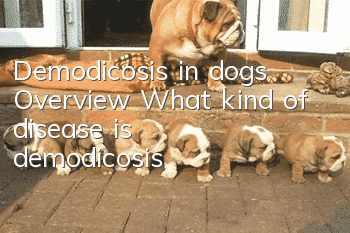Demodicosis in dogs Overview What kind of disease is demodicosis?

Symptoms of canine demodicosis
After infection, the dog's skin manifests as papules and itching, which are more common at the end of the limbs/ears/face/auricles/ventral and lower abdomen, and gradually spread whole body. Early manifestations include erythema/papule/severe itching, bleeding/scab due to dog biting, and formation of scab. Hair loss/skin thickening in the lesion. The dog is restless and has a decreased appetite. If secondary bacterial infection occurs, deep pyoderma will develop.
Cause of canine demodicosis
Canine demodicosis is a skin parasitic disease in dogs caused by Demodex mites in the family Demodicidae and genus Demodex. It lives in the sebaceous glands and hair follicles of dogs. This disease is also called trichocystis or lipid mange. It is a common and stubborn skin disease.
Demodex is a small parasitic mite. Females are 0.25-0.30 mm long and 0.045 mm wide. The male worm is 0.22-0.25 mm long and about 0.045 mm wide. The body of the insect can be divided into three parts: head, thorax and abdomen. The mouthparts are composed of a pair of pedipalps, a pair of spiny chelicerae and a lower oral plate; the thorax has 4 pairs of very short legs, the abdomen is slender, and the surface Densely covered with horizontal stripes. The male's genital pore opens on the back. The genital pore of the female is on the ventral surface. The eggs are spindle-shaped and about 0.07-0.09 mm long.
Life history of canine demodicosis
All developmental processes of canine Demodex occur in the dog's body. The female lays eggs at the parasitic site. The developmental history is divided into four stages: egg, larvae, nymph and adult. The eggs hatch into larvae with three pairs of legs at the parasitic site, then turn into nymphs with four pairs of legs, and finally into adults. In addition to parasitizing hair follicles and sebaceous glands, canine Demodex can also live in lymph nodes, grow and reproduce in lymph nodes and become endoparasites.
This disease often occurs due to contact between sick dogs and healthy dogs. Indirect infection through vectors is also possible. Demodex mites are highly resistant and can survive in the outside world for many days and can infect people. Children and women are more susceptible than men.
There are two types of canine demodicosis
The symptoms of Demodex can be divided into two types.
Scaly type: Mainly hair loss and bald spots occur in and around the eyelids, forehead, lips, lower neck, elbows, between toes, etc., with clear boundaries, accompanied by skin Mild flushing and bran-like flaky skin, the skin may be rough and cracked, and some may have small nodules. The skin may turn gray-white and the affected area will not itch. Some can remain prototypes for a long time.
Pustular type:After infection with Demodex, red papules are often seen in the lower abdomen of the femur. After a few days it turned into a small abscess. In severe cases, there are large areas of red and white protrusions in the lower abdomen and the inner side of the femur, and there is a smell. Sick dogs will show restlessness and itchiness. When a large number of Demodex mites are parasitized, it can cause systemic skin infection, hair loss, pustular ulcers, secondary bacterial infection, systemic symptoms, and death in severe cases.
- What should dogs eat if they are deficient in trace elements?
- Why do dogs eat shit?
- If a dog bites someone, it’s because he’s not trained, right?
- What is the difference between dog colds and canine distemper? A must-read for dog scrapers!
- What are the differences in hair care for different dogs? Do you know these care methods?
- What should you pay attention to when training your dog?
- When can puppies be weaned from eating dog food?
- What medicine should a dog take if he has a fever?
- How to make your dog’s hair more beautiful, how to beautify and care for your dog’s hair
- Do dogs need to be dewormed frequently? When is the time to deworm dogs?



